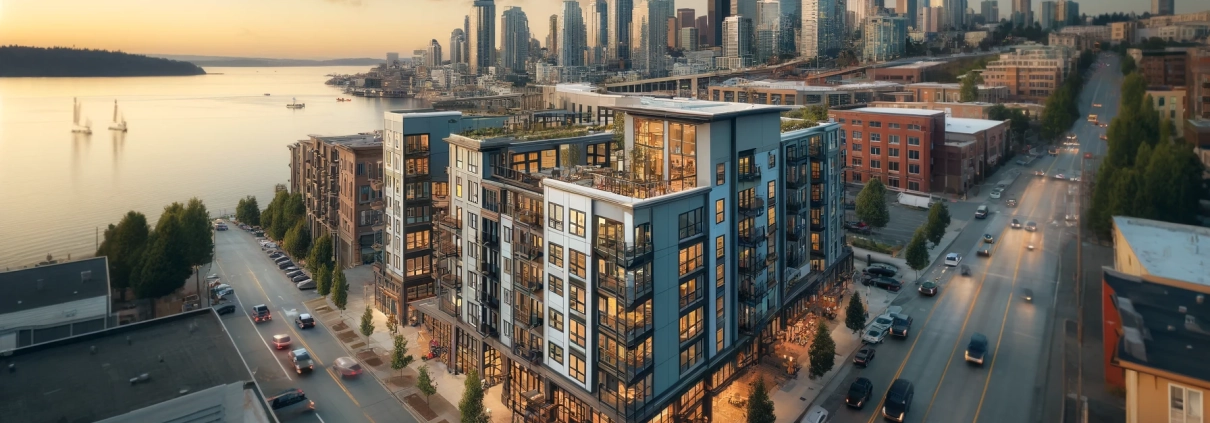Unlevered Cash Flow
The net cash inflows and outflows of a real estate investment before taking into account cash flows related to financing. Unlevered cash flows generally consist of total investment costs, net operating cash flows before financing, and asset reversion cash flows (i.e. net proceeds from sale). In real estate financial analysis, the unlevered cash flow line is used to calculate the unlevered internal rate of return and unlevered equity multiple of a prospective real estate investment.
Putting ‘Unlevered Cash Flow’ in Context
Imagine Puget Green Residences, a newly built market-rate apartment complex located in the bustling heart of Seattle, WA. This property, featuring 200 modern units and amenities such as a fitness center, rooftop terrace, and underground parking, represents a typical core investment targeted by GreenOak Core Fund, an open-end core fund (ODCE fund).
The Investment
GreenOak Core Fund specializes in acquiring stable, high-quality assets in prime locations with minimal risk. Puget Green Residences, with its high occupancy rates and consistent rental income, fits perfectly into their investment strategy. The fund decides to purchase this property for approximately $80.98 million, aiming to maintain a stable cash flow from rents which average $2,500 per unit per month.
Unlevered Cash Flow Overview
In an “unlevered” scenario, the financial performance of Puget Green Residences is analyzed without the impact of financing. This provides clarity on the actual operational effectiveness and potential returns from the property itself.
Calculation of Unlevered Cash Flows
- Total Investment Costs: $80.98 million (Purchase Price)
- Annual Operating Cash Flows:
- Annual Rental Income: $6 million (200 units x $2,500/month x 12 months)
- Other Income (e.g., parking, laundry services): $200,000 annually
- Vacancy Rate: 5% of potential rental income ($300,000)
- Effective Gross Revenue: $5.9 million ($6 million + $200,000 – $300,000)
- Operating Expenses: $1.77 million (30% of Effective Gross Income)
- Net Operating Income (NOI): $4.13 million per year
- Asset Reversion (End of Hold Period): Assuming the property is sold at the end of a 10-year period, at a 5% capitalization rate based on a projected NOI of $4.5 million, the expected sale price would be approximately $90 million.
Unlevered Returns
– Unlevered IRR: The fund targets a minimum 6.5% unlevered IRR, calculated using the total investment costs, annual unlevered cash flows, and the net proceeds from the sale, reflecting the asset’s performance over the investment period without debt influences.
Investment Strategy
GreenOak Core Fund aims to hold Puget Green Residences unlevered given the low risk (core) nature of their investment strategy. This approach aligns with the fund’s preference for lower-risk, stable return profiles, and simplifies management and financial analysis of the property.
Analysis
Calculating unlevered cash flows allows GreenOak Core Fund to assess the pure performance of Puget Green Residences. This simplifies the investment analysis and risk assessment, providing transparency for fund contributors looking for stable, low-risk returns, and forms the basis for calculating key investment metrics like unlevered IRR and equity multiple.
Frequently Asked Questions about Unlevered Cash Flow in Real Estate Analysis
What is unlevered cash flow?
Unlevered cash flow is the net cash inflows and outflows of a real estate investment before considering any financing. It includes total investment costs, net operating cash flows, and asset reversion cash flows.
How is unlevered cash flow different from levered cash flow?
Unlevered cash flow excludes the effects of debt—such as loan payments, interest, and financing fees—while levered cash flow includes those financing-related elements.
How is unlevered cash flow used in investment analysis?
It is used to calculate metrics such as unlevered IRR and unlevered equity multiple, giving investors a view of the asset’s performance independent of financing decisions.
What unlevered cash flow figures were used in the Puget Green example?
The example included:
Effective Gross Revenue: $5.9 million
Operating Expenses: $1.77 million
Net Operating Income: $4.13 million
Sale Proceeds: ~$90 million at a 5% cap rate on projected Year 10 NOI
Why did GreenOak Core Fund choose to analyze the investment unlevered?
Because their core investment strategy focuses on stable, low-risk assets, they evaluate properties without the influence of debt to maintain transparency and simplicity in financial modeling.
What was the target unlevered IRR in the example?
GreenOak Core Fund targeted a 6.5% unlevered IRR based on projected cash flows and future sale value.
What related models or tools can help with unlevered analysis?
You can use tools like:
Pro Forma for Multifamily Renovation
All-in-One (Ai1) Model
Real Estate Portfolio Valuation Model
Condominium Development Model
Where can I download the full glossary in PDF format?
Click the link in the post that says “Click here to get this CRE Glossary in an eBook (PDF) format.”
Click here to get this CRE Glossary in an eBook (PDF) format.

